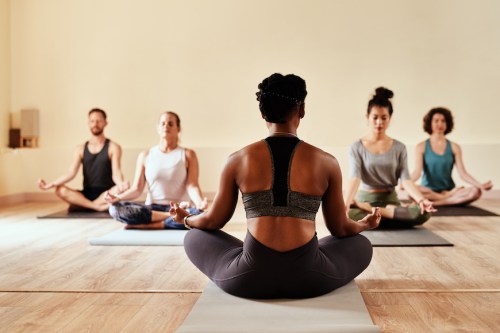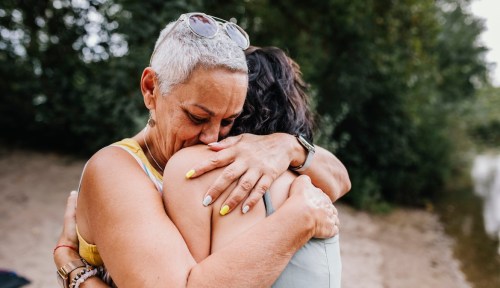“When I was conceptualizing HealHaus and thinking about what the physical space would look like and the energy that it would give off, I was always wondering, ‘Why are all wellness spaces white, sterile, gray?'” said Elisa Shankle, co-founder of the Brooklyn wellness center, during the most recent Well+Good TALK, entitled “There’s a Diversity Problem in Wellness.”
Experts in This Article
Elisa Shankle married her love for design (she holds an interior design degree from Pratt Institute) with her passion for holistic health to create HealHaus, a cafe and healing space in Brooklyn. Elisa is Reiki 2 attuned and explores her own healing practice through different mediums to access mind, body, and spirit.
Her observation is that there’s a relationship between wellness and whiteness that literally comes down to the colors of its spaces: rooms with white walls; stocked with white towels; and filled white, thin, blonde women who have $90 yoga mats slung over their shoulders. And to be sure, it’s an urgent problem that needs a solution. “Even just from a visual [perspective], it was always very confusing to me and also a very oppressive space, to me, personally,” she added.
“When I was conceptualizing HealHaus…I was always wondering, ‘Why are all wellness spaces white, sterile, gray?’ It was always very confusing to me and also oppressive.” —Elisa Shankle, HealHaus co-founder
Rethinking the whitewashed aesthetics of wellness spaces is an early but necessary step to take in order to decolonize wellness and ensure it not only stops being oppressive but also starts being an avenue of healing for all. “To me [having inclusive aesthetics] feels natural and normal, but it’s definitely not something that is present in a lot of wellness spaces,” Shankle says. “You often see a very consistent look, feel, and usually appropriated religion in spaces. [At HealHous], I also wanted to have a very neutral space from spiritual practices.” That also means not using appropriated religious and cultural practices in the wellness space—like Buddha statues, dream catchers, and smudge sticks.
Beyond being visually oppressive, whitewashed wellness spaces rife with appropriated decor back up other problematic roots of whiteness. To name two examples, there’s the white centering of coopting and repurposing traditions without providing cultural context and the white elitism of the high price tags of admission to sessions and treatments in these spaces, which economically reinforces the racial realities of the wellness gap. The problematic whitewashed messaging is rampant in the wellness world, and it needs to change so all people can engage with wellness in an authentically life-improving way.
What white aesthetics convey
In her Spiritual Activism 101 online workshop, racial-justice educator and Well+Good Changemaker Rachel Ricketts makes the point that when asked to close your eyes and conjure “black” and then “white,” whiteness is often associated with ethereal terms, like lightness and heaven, whereas blackness is often associated with heavier terms like, darkness and negativity. These associations translate directly to implicit bias, given that research has found that darker skin tones are associated with the perception of immoral acts. There’s also long been societal messaging about blackness signifying dirtiness, a notion communicated as literally as being featured in soap advertisements for hundreds of years.
Now, contrast this with what a white dress has come to signify in the U.S. and other Eurocentric cultures. White dresses are the chosen uniform for baptisms, first Communions, purity balls, and debutante balls. And of course, there’s the white wedding gown, a custom that began in the Victorian era and never stopped because, as the magazine Godey’s Lady’s Book put it, it was the “emblem of the purity and innocence of girlhood, and the unsullied heart she now yields to the chosen one.” This is another way the color has been used as a white-culture-centering measure, oppressing groups for which white wedding dresses are not and never have been a thing at all. In fact, in a number of cultures, white is a color of mourning, which is why certain East Asian cultures wear white clothing to funerals and Indigenous Australian widows wear white mourning caps.
To be sure, there are connections to the color white that a number of global cultures hold. In Chinese feng shui, for example, white represents the metal element and signifies endings giving way to new beginnings. And in Japanese culture, white represents holiness, purity, and even joy. But, the way in which white is used in the modern yoga studio is more often than not just emblematic of white supremacy coopting and appropriating the roots of different cultures.
So given these examples of ways in which Western society interacts with the colors white and black, consider how those aesthetic disparities are supported and propelled in wellness spaces. If you step into a healing space—like a yoga studio, a spa, a retreat—what’s likely being reflected back by the expensive minimalist decor and walls?
If wellness is coded as white, we can start decolonizing it by dismantling its design
Rethinking decor is one way wellness spaces can be more inclusive and less white-centric (literally). For Shankle, that meant putting her interior-design background to work and making HealHaus an inclusive, neutral space that vibrated with colors of the Earth and a sense of warmth.
“A healing space is about a warm space—something that feels nurturing, something that feels nourishing and not intimidating,” she said. “You come in, and you see what resonates with you. I feel like that’s not often the agenda of the wellness industry. It’s very much telling you and selling you what you need to do. But for [HealHaus], it’s just about literally holding space.” What’s clear is that on the road to ensure wellness is accessible and inclusive, when it comes to physical, visual spaces, every paint chip counts.
Sign Up for Our Daily Newsletter
Get all the latest in wellness, trends, food, fitness, beauty, and more delivered right to your inbox.
Got it, you've been added to our email list.











